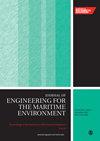Application of swarm intelligence for dynamic properties of moored floating structures using two-dimensional fluid dynamic program
IF 1.5
4区 工程技术
Q3 ENGINEERING, MARINE
Proceedings of the Institution of Mechanical Engineers, Part M: Journal of Engineering for the Maritime Environment
Pub Date : 2023-01-04
DOI:10.1177/14750902221143596
引用次数: 1
Abstract
This paper presents a numerical investigation into interactions between oscillatory waves and moored floating structures by through applying Swarm Intelligence (SI). The effects of small and large incident waves placing a force on the obstacles were studied using two floating structures composed of a rectangle and a cage kind with taut-moored and slack-moored situations. The aforementioned problem was reduced to solve systems of sparse-nonlinear equations for surge, heave, and pitch responses, as well as mooring forces considering that there is a distorted wave motion due to the presence of the movable obstacle boundary. The particle swarm optimization (PSO) algorithm is proposed here to provide insight into computational intelligence factors affecting calculation results and efficiency. Besides that, a computational fluid dynamic (CFD) program is based on a full Navier-Stokes solver. A series of numerical examinations for selected wave heights and wavelengths including a set of optimization procedures have been taken into account in the evaluation of formulated objective function, F, where the best potential solution is computed at each computational step. Meanwhile, a collection of empirical benchmarks were also developed based on reported measurements in the literature to provide sound empirical support for the theoretical findings. The results show that the optimization method exhibits a favorable convergent behavior (F≈0), where the computed results agree well with the measurements in terms of mean amplitudes of the surge, heave, and pitch responses and peak values of mooring-line tensions. The approach would firmly converge on benchmarks with improved computational steps of 18,321 running for 20.1 wave cycles in the case of the taut-moored rectangular structure. For the slack-moored cage, a satisfactory convergence was achieved using a series of data calibrations into an algorithm that took 27,976 iterations and 24.5 s to complete. Furthermore, CFD captures of wave deformations, dynamic forces, and streamlines were able to qualitatively corroborate the results.基于二维流体动力学程序的群智能在系泊浮体结构动力特性分析中的应用
本文应用群智能(Swarm Intelligence, SI)对振动波与系泊浮体之间的相互作用进行了数值研究。采用矩形浮体和笼型浮体,研究了大、小入射波对障碍物施加作用力的影响。考虑到由于可移动障碍物边界的存在而导致波浪运动失真,上述问题被简化为求解脉动、升沉和俯仰响应以及系泊力的稀疏非线性方程组。本文提出了粒子群优化算法(PSO),以深入了解影响计算结果和效率的计算智能因素。此外,计算流体动力学(CFD)程序是基于一个完整的Navier-Stokes解算器。在公式化目标函数F的评估中,考虑了对选定波高和波长的一系列数值检查,包括一组优化程序,其中在每个计算步骤中计算最佳潜在解。同时,基于文献报道的测量结果,本文还开发了一套实证基准,为理论发现提供了良好的实证支持。结果表明,该优化方法具有良好的收敛性(F≈0),计算结果与实测结果在浪涌、升沉、俯仰响应的平均幅值和系泊索张力峰值方面吻合较好。在拉紧系泊矩形结构的情况下,该方法将坚定地收敛于基准,改进了18,321个运行20.1个波周期的计算步骤。对于松弛系泊笼,采用一系列数据校准算法,实现了令人满意的收敛,该算法迭代27,976次,耗时24.5秒。此外,CFD捕获的波浪变形、动力和流线能够定性地证实结果。
本文章由计算机程序翻译,如有差异,请以英文原文为准。
求助全文
约1分钟内获得全文
求助全文
来源期刊

CiteScore
3.90
自引率
11.10%
发文量
77
审稿时长
>12 weeks
期刊介绍:
The Journal of Engineering for the Maritime Environment is concerned with the design, production and operation of engineering artefacts for the maritime environment. The journal straddles the traditional boundaries of naval architecture, marine engineering, offshore/ocean engineering, coastal engineering and port engineering.
 求助内容:
求助内容: 应助结果提醒方式:
应助结果提醒方式:


